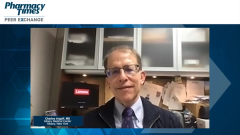
Current State of the Opioid Crisis: Multifaceted Point of View
Charles Argoff, MD, describes the current state of the opioid crisis from a multifaceted point of view, as well as provide context for upcoming discussions.
Episodes in this series

Peter Salgo, MD: Hello and welcome to this Pharmacy Times® Peer Exchange: “The Opioid Crisis, a Multidisciplinary Perspective on Effective Management.” I am Dr Peter Salgo; I’m a professor of medicine and anesthesiology at the Columbia University College of Physicians and Surgeons, and associate director of surgical intensive care at New York-Presbyterian Hospital.
Joining me is a distinguished panel that includes Dr Jeremy Adler, physician assistant, partner, and chief operating officer at Pacific Pain Medicine Consultants in Encinitas, California; Dr Charles Argoff, professor of neurology at Albany Medical College, and director of the Comprehensive Pain Center at Albany Medical Center; Dr Jeffrey Bratberg, pharmacist and clinical professor of pharmacy practice at the University of Rhode Island College of Pharmacy; Dr Joshua Lynch, clinical associate professor of emergency medicine for the University at Buffalo Jacobs School of Medicine and Biomedical Sciences; and Theresa Mallick-Searle, nurse practitioner within the Division of Pain Medicine at Stanford Health Care in Palo Alto, California.
Today we are going to discuss topics pertaining to the opioid crisis, including the challenges and recent guidance provided by national agencies, as well as provide practical perspectives on how to apply effective management strategies into your clinical practice.
We are going to get started right away. Why don’t we start by talking about the opioid crisis from the beginning? First of all, what is the current state of the opioid crisis and frankly, is it a crisis, or is this something that is being cooked up in the media and by politicians? Is there really a problem out here at all?
Charles Argoff, MD: There certainly is a problem. It depends on how you want to look at the problem. Let’s look at it from a multifaceted point of view, and I do appreciate how you and my colleagues feel about this and what you have to say as well.
If you think about it, there is a crisis in terms of an opioid abuse crisis. There are people who are dying from overdoses due to opioid utilization. However, we have to examine that more deeply, and I hope we get to do that during this program.
For example, it has become clear that the number of prescription opioids being utilized—so prescription opioid use—has declined. The number has declined dramatically in the last couple of years, yet CDC data and other data clearly state that the number of overdose deaths due to opioids is increasing, and the data also suggest that these opioids are semisynthetic. These are opioids that are not coming from prescriptions. That is a crisis unto itself, and in addition, there is a crisis that we can touch upon today that has to do with those people who have summarily been told, “You can no longer have your opioid prescription.” These are people who have been doing well for years and years and years on a pain management regimen that included opioids who have somehow been told that, due to the opioid crisis, we can no longer prescribe them opioids.
Peter Salgo, MD: I have got to feel sympathy for a lot of practitioners out there, because for the longest time I was taught in medical school, and others were taught, that if you give opioids for a specific condition, and you monitor your patients, they don’t get addicted; this isn't a problem. And by the way, pain was the extra vital sign that everybody was mandating that we measure. Suddenly, everybody is doing that. Now we’re being told, “Look what happened. You are doing it wrong again.” You cannot win here. Do you feel bad for the practitioners out there?
Jeremy Adler, DMSc, PA-C, DFAAPA: It is not exactly framed the way that it might sound, especially to those who are not in the field. One of the things I think is critical that was already mentioned is that we are in an opioid crisis, but where these opioids come from really is important. We have the synthetic opioids, which are illicit. These are not manufactured within standardized pharmacies. We also know from the governmental data that the majority of people who misuse an opioid get it without a prescription. They usually get it from a friend or a family member; there is diversion that occurs. It is a little complicated to directly link prescribers, the guidelines, and the prescription opioids that are used in the medical space, directly to the community in a linear fashion, to people who are misusing opioids and overdosing as a result.
Peter Salgo, MD: I guess that is what I was getting at, that the people taking a lot of the heat here are the pharmaceutical companies or the practitioners, but a lot of this is outside of the practitioner sphere, if you will. It is a complicated issue.
Charles Argoff, MD: I think it is even more complicated. I am sorry for interrupting, but it’s complicated, because there was a time when pain was being thought of as the fifth vital sign, which meant that hospitals were being judged; satisfaction scores were based upon their pain management, and people were getting certain medications to satisfy those scores. They were not necessarily the best option. You are an anesthesiologist, so I am sure you understand the kind of pressures we are facing—people were being exposed—but at the same time, opioids are not the right class of medicine for all people. Prescribing opioids is not the right treatment for all people.
Peter Salgo, MD: You are implying that the hospitals were teaching to the test.
Charles Argoff, MD: Right, if 10% of people—I’m making that number up—but if 10% of people are likely to get in trouble with opioid use, they are not the right candidates. If you increase the number of people who are exposed to opioids, there will be an increase in the number of people who are going to get into trouble. I think we are reacting, in part, to that because we are seeing that, as we have a decrease in prescribing, the number of people who are in trouble is still going up.
Theresa Mallick-Searle, MS, RN-BC, ANP-BC: This is a problem, particularly now with COVID-19 and all of that. We could spend the next 90 minutes talking about this one particular topic. It is a complex problem, and in my opinion, it’s more of a crisis of health care being able to manage pain appropriately, and the opiate becomes the scapegoat.
Transcript edited for clarity.
Newsletter
Stay informed on drug updates, treatment guidelines, and pharmacy practice trends—subscribe to Pharmacy Times for weekly clinical insights.


























































































































































































































